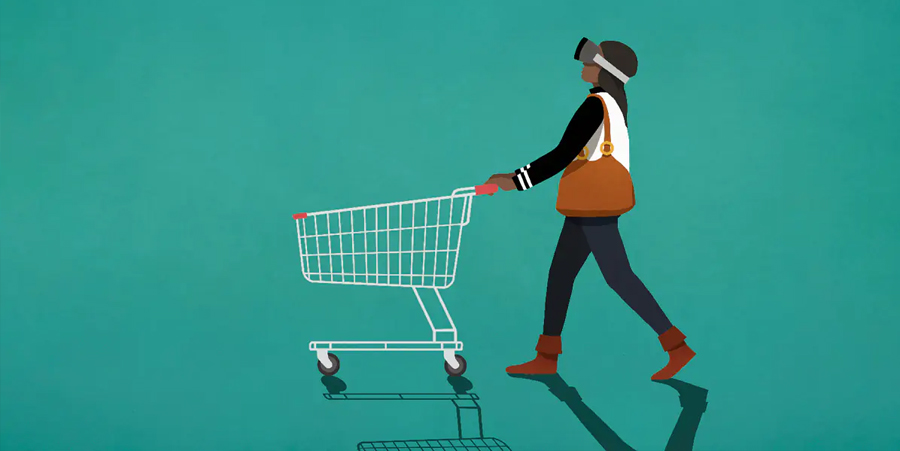The way we shop is changing, and brands that don’t keep up will miss out on demand generation
Editor’s note: Today’s column is part of a series with Snap on augmented reality. Below, Kathleen Gambarelli, global head of product marketing for performance solutions, demonstrates two key ways that AR technology can instill confidence and inspiration in consumers—and the brands trying it out.
From the groceries in our fridge to the shoes on our feet, shopping is a significant part of our everyday lives—and as technology advances and consumer needs change, so does the way we buy everything.
While storefronts will certainly always be part of the retail experience, the modern concept of a storefront is determined by your access to the internet, not your physical location. It used to be that we could only make purchase decisions based on what we saw on shelves—now, shoppers are guided by online reviews and recommendations from influencers and close friends. Whether you’re booking a flight, buying apparel, ordering food or subscribing to a streaming service, the entire customer journey can now take place on a mobile device.
With the internet making it possible to shop anywhere at any time, mobile commerce depends on convenience. At the same time, the shopping experience should instill confidence and inspire consumers in the tangible ways they’d expect to shop IRL.
Confidence is defined by the knowledge that your customer can make the best purchase decision based on recommendations from their close friends or crowdsourced reviews. Shoppers can trust they’re buying the right product based on the color, style or fit that’s right for them, and feel a sense of relief that their personal and sensitive information is not being shared or sold. Inspiration is defined by unique modes of product discovery that are personalized, rich in information and fun.
So what does it take to capture consumers’ attention on mobile at a time when the advertising world is going through unparalleled changes? Performance marketing looks a lot different than it did just two years ago, so brands should keep two things in mind to ensure an effective, durable commerce strategy for the future: augmented reality and the importance of demand generation.
Shopping, augmented
When it comes to commerce, the power of AR is becoming abundantly clear, particularly in the ways it can foster confidence and inspiration in shoppers. While nothing can replace the tactile experience of a physical product trial, advancements in camera technology and AR software are bridging some of the gaps.
For example, ray tracing simulates realistic lighting, shadows and reflections on objects, capturing the subtle details your brain expects to see as an item interacts with its surroundings. This approach has long been used in television and film via sophisticated computers with long processing times. In the coming months, for the very first time, this technology will be made available through Snapchat’s Lens Studio, enhancing AR experiences across a broad range of mobile devices. You can see how ray tracing has transformed this 3D Tiffany & Co. Bird on a Rock brooch.

Brands can unlock virtual try-on by transforming 2D images from a standard product catalog into 3D assets. Suddenly, the consumer can be the model of the desired item rather than relying on the image they see onscreen.
That’s the beauty and the promise of AR. It creates a shift in the consumer mindset—instead of a passive experience, online shopping is elevated into an interactive one, instilling shoppers with more confidence before they buy. This is why AR-guided purchases lead to a 25% decrease in returns and interacting with AR products drives a 94% higher conversion rate.
The importance of demand generation
Over the last two years, the global pandemic created myriad disruptions to commerce, from supply chain issues and economic volatility to a rapid pivot toward online as the dominant sales channel. This has forced businesses to be more cost-conscious than ever, placing a premium on tried-and-true tactics that drive short-term ROI—but at the expense of longer-term demand generation.
While a lower cost per acquisition may be alluring, it is ultimately unsustainable when there isn’t adequate investment in demand creation, and businesses end up optimizing themselves out of effectiveness. Research shows the most successful brands spend about 60% of their overall budget on brand-building efforts and only 40% on sales activation activity. This ratio is even more pronounced for online-only brands.

When costs, resources and even brand assets are in short supply, maximizing return on effort becomes even more critical. Brands should seek out platforms that offer an expansive set of solutions, catering to the full range of their customers’ journey while ensuring a balanced investment in upper- and lower-funnel objectives concurrently.
Even better? When brands can use the same creative assets to serve multiple outcomes. AR has come a long way on this front—since its inception, it’s been an innovative vehicle to drive brand awareness, and now it offers some of the most compelling features for commerce, revolutionizing the way we shop.
This article first appeared in www.adweek.com
Seeking to build and grow your brand using the force of consumer insight, strategic foresight, creative disruption and technology prowess? Talk to us at +971 50 6254340 or engage@groupisd.com or visit www.groupisd.com/story


